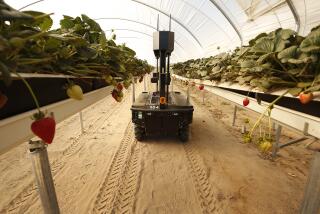Agritech Plots Revolution Down on Farm : Robots, Computers to Bring in the Crops
- Share via
Even before the nation’s current farm depression began, agriculture in Orange County--once an industry of national importance--was on the wane.
But even as tract homes, commercial offices and plush research and development complexes gobble up the county’s farm and orchard acreage, a number of Orange County companies have emerged as leaders in a new high-technology field that could spur an agricultural revolution in the West.
Robots that harvest orchard crops, sensors that determine optimum plant moisture levels and computers that control when and how much water to apply to crops are some of the devices being created and refined in the county.
Although electronic technology has permeated almost every other aspect of American business, farming--especially in California--remains an enterprise that in some ways is unchanged from biblical times:
- Crews of laborers still plant, weed and pick vast tracts of land by hand.
- Crop yields still fluctuate markedly because of a reliance on rain that fails to arrive when needed and on irrigation water that often isn’t applied at precisely the right time.
- Expensive irrigation water still is wasted because too much is applied, and the excess runs off into drainage channels.
Robots on Job Night and Day
By the 1990s, however, these problems could be as passe as plowing with mules, agribusiness experts say.
Replacing teams of migrant laborers in the fields will be robots that will work night and day until the crop is harvested. And infared sensors that monitor moisture levels in the soil will be coupled to computers to make sure that irrigation water is delivered at the right time and in the right amounts to nourish the crop without wasting a drop.
Advancing technology is “absolutely” playing an increasingly important role in agriculture, said Jim Basselman, a spokesman for the Michigan-based American Society of Agricultural Engineers.
Perhaps one of the most significant agritechnology projects is under way at Odetics Corp., the Anaheim-based company with interests in robotics and digital, audio and video recording equipment.
Under a $45,000 grant from the U.S. Department of Agriculture, and in conjunction with the University of Florida, Odetics has completed detailed design specifications for an Automated Citrus Fruit Harvester.
The company anticipates a second federal contract to actually develop and demonstrate a mobile robot capable of automatically harvesting an orange crop.
Each device would consist of four separate robotic pickers mounted on a platform. A visual targeting device similar to that used in military systems would “see” the oranges and direct the picking arms to the fruit, which would be placed on a conveyor as the platform moves along the rows of trees.
Although the prototype system is being developed specifically for oranges, the nation’s largest orchard commodity, it could be adapted for other crops, said Tom Bartholet, general manager of Odetics’ advanced intelligent machines division.
Devices ‘Inevitable’
“Orchard crops are one of the last areas in agriculture to be automated,” Bartholet said.
The automated picker still needs further development work, he acknowledged, but such devices are “inevitable” in the fields, he said.
How efficient is the 12-armed mechanical harvester?
It could duplicate the work of 55 workers, Bartholet said. And because the robots don’t get tired, they can work all day, all night, all week.
With the robot picker’s price tag estimated at between $100,000 and $200,000, the savings in labor costs for an orchard owner would come “early in the third season,” Bartholet estimates. Those statistics are likely to be tempting to orange growers because manual labor typically accounts for 20% of their costs.
Another substantial cost in agriculture is water, particularly in the arid Southwest.
To help cut costs--and, more important, to conserve diminishing water supplies--a pair of Orange County companies, working independently of one another, have developed systems for detecting the best times to apply water and for applying it automatically and in just the right amount.
Everest Interscience Inc., in Fullerton, has borrowed technology developed for the federal space program to developed a system that uses infrared temperature sensors to detect crop stress caused by a lack of water.
Everest officials said the system allows a farmer to identify areas that need water and to apply the water at the optimum time. Because large farm operations can have $1-million water bills, such precision information can result in substantial savings and increased yields, the company said.
The system works by collecting a sample of radiant heat from the leaves of a crop. The higher the temperature of the leaves, the greater the stress. The sensing system works because plants grow by taking in carbon dioxide and allowing moisture to evaporate through pores in their leaves--high temperature means less moisture is evaporating.
“Technology keeps on going and going and going,” said Steve Giffin, a spokesman for the company. A hand-held infrared thermometer “gun” costs about $2,000 and allows the farmer to “read” thousands of plants at one time.
Energy Management Corp. of Los Alamitos also is using high-tech to help farmers use their precious water supplies to the best advantage.
The privately held company has developed a system that measures soil moisture with sensors that transmit data to a remote terminal and then onto a computer in the farmer’s office where irrigation can be started. An experimental system on an Arizona farm cut water use by 20%, the company said.
Because it saves energy and reduces runoff, computer-controlled irrigation is coming, said Bill Fairbank, an agricultural engineer at the University of California, Riverside.
Thus far though, Energy Management hasn’t sold any of the systems, which it spent $500,000 developing. The situation is symptomatic of the hard times on the farm.
“It’s a little tough right now,” said James R. Dunn, president and part owner of the company. “Many farmers are overextended (and) low commodity prices have hurt farm investment.”
Dunn nonetheless is optimistic that such systems will be essential in the near future. Farmers who survive the current shakeout “will have to use the best tools available to them to insure their efficiency,” he said.
What the three Orange County companies--and others like them throughout the nation--are doing is critical.
Many experts believe that farmers in the United States already have lost their edge over foreign growers in much the same manner the country’s industrial segment lost its edge--by clinging to old and inefficient methods.
Without developments like those being turned up by the Odetics and Everests, the nation could lose its longstanding place as the world’s leading agricultural producer, some specialists argue.
Losses to Mexico
“Our growers cannot compete on the basis of hand labor,” said Roger Garrett, professor of agricultural engineering at the University of California, Davis. Garrett notes that commodity production is being lost to Mexico, for example, at the expense of California farmers.
Garrett said the United States currently is not allocating enough resources to foster the research needed to reverse the decline in domestic agriculture.
And if the United States doesn’t remain first in agricultural technology, he said, “we are going to be hurt.”
Garrett and other agricultural specialists believe that countries are pushing technological developments much faster than the United States.
Two of the best-funded agritech projects at UC Davis are financed by the governments of Spain and Israel. Interest in agritech is “much higher” overseas, Garrett said.
But Bill Tallent, assistant administrator of the Department of Agriculture’s research service, says the Reagan Administration is fostering “closer cooperation between federal research organizations and industry.” Recently signed legislation “authorizes, encourages and facilitates” this closer link, he said.
‘Slipping a Little’
Tallent said he is confident the United States still is the leader in agritech research although he acknowledged that “we’ve been slipping a little.”
Advancing agritechnology promises change that extends far beyond the fields and packing plants.
Because of the continuing agricultural slump, demand for the advanced agritech products being produced in Orange County and elsewhere in the nation has been muted.
But once agriculture recovers, experts expect advanced technology to move quickly into the fields because the survivors, whether they are small farmers or corporate giants, will be forced to adopt advanced technology to remain competitive.
Reductions or elimination of the federal government’s price-support systems, which would have the effect of deregulating American agriculture, also is likely to prompt farmers to embrace advanced technology methods to remain competitive, experts conclude.
But whatever the prompting, few question the coming of a sweeping technological revolution in agriculture.
The only debate is when.
More to Read
Inside the business of entertainment
The Wide Shot brings you news, analysis and insights on everything from streaming wars to production — and what it all means for the future.
You may occasionally receive promotional content from the Los Angeles Times.










